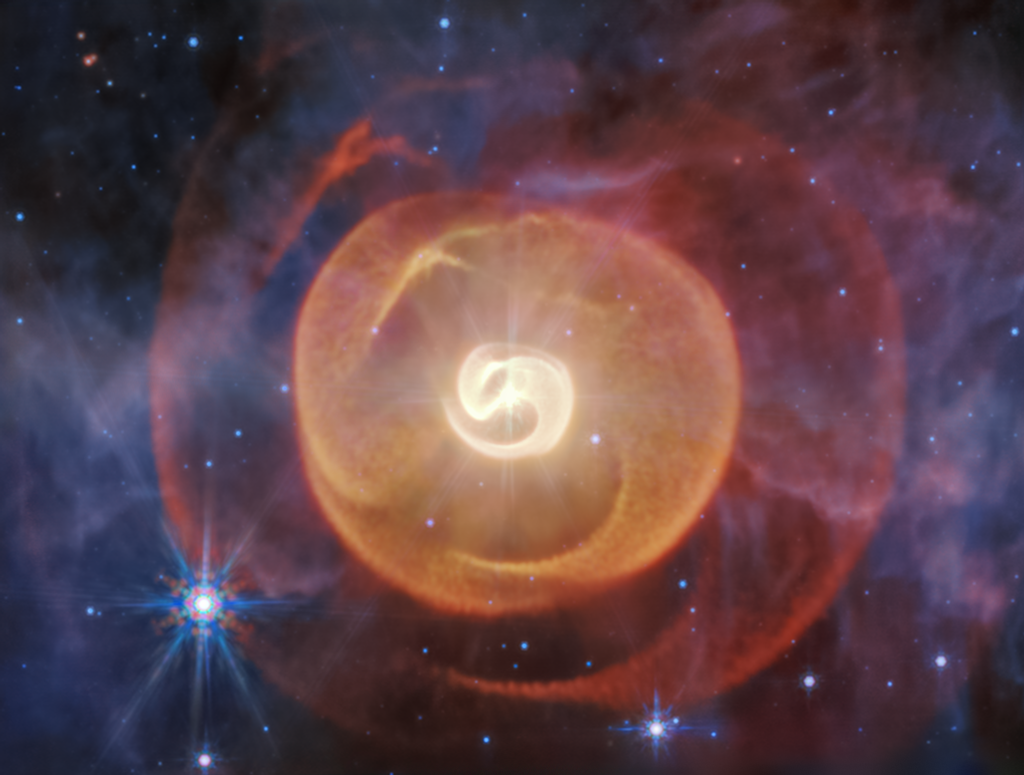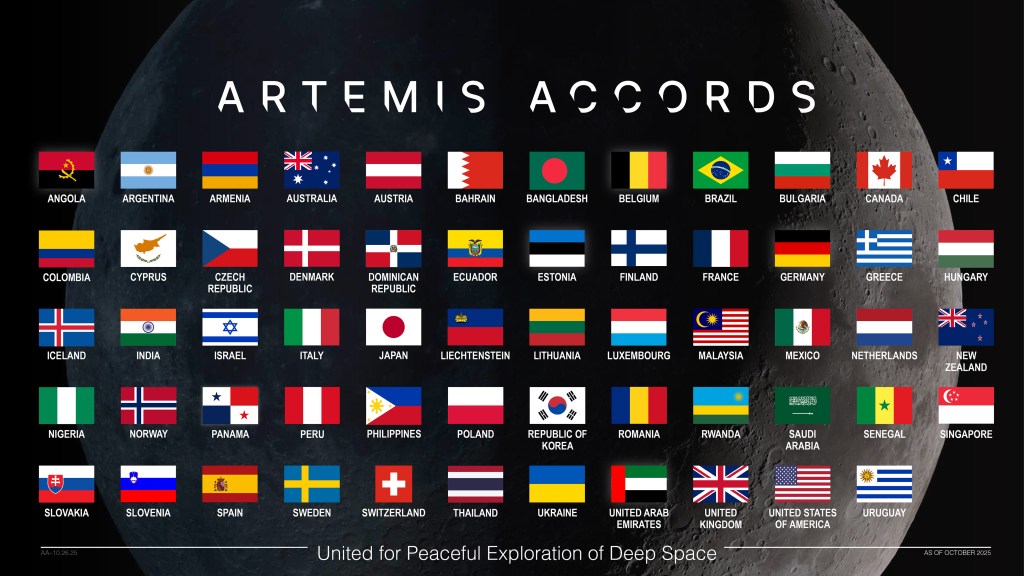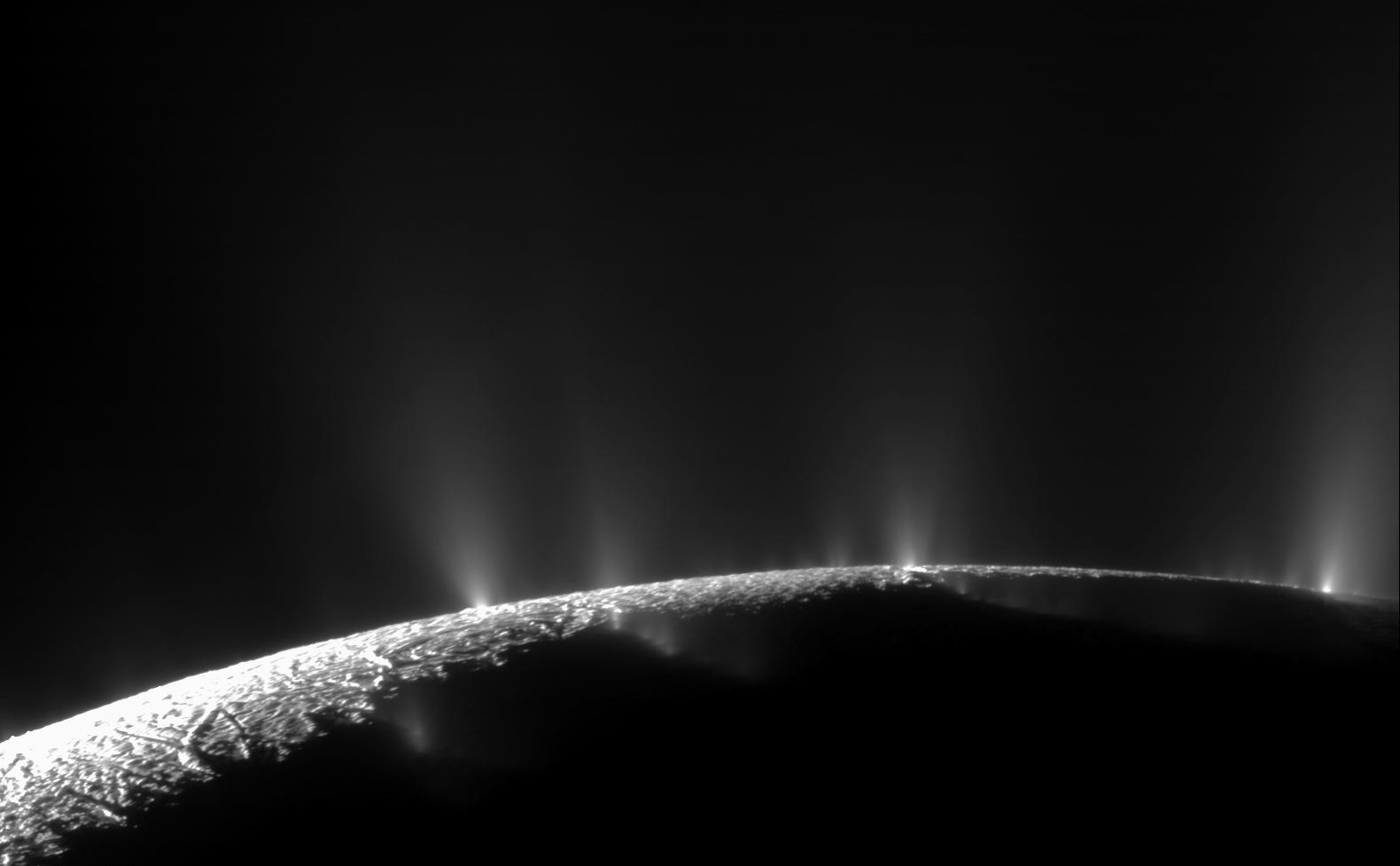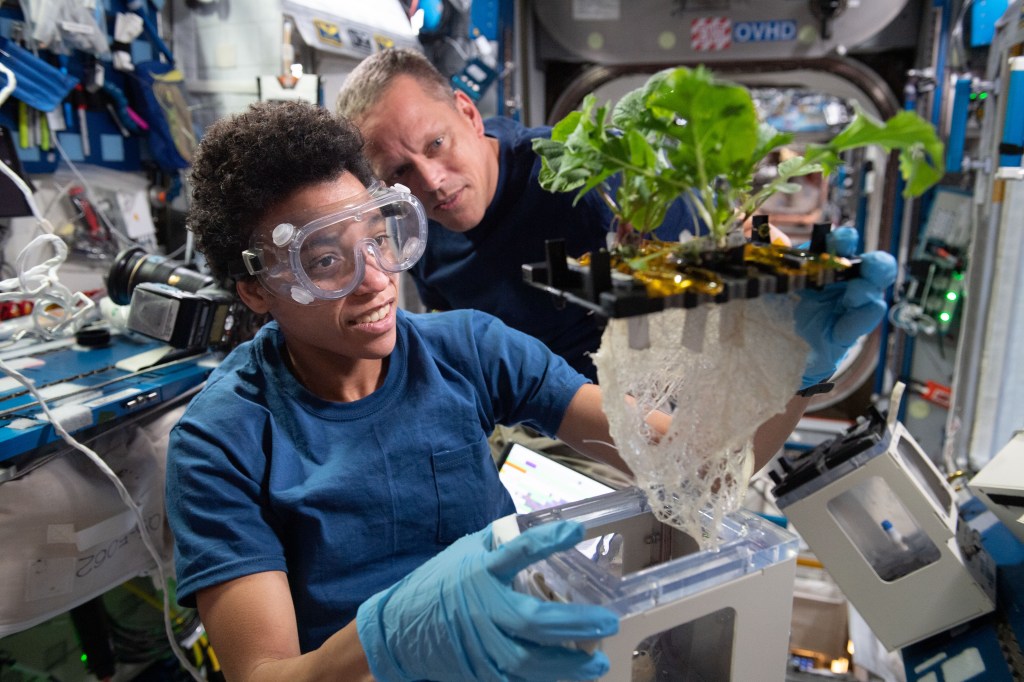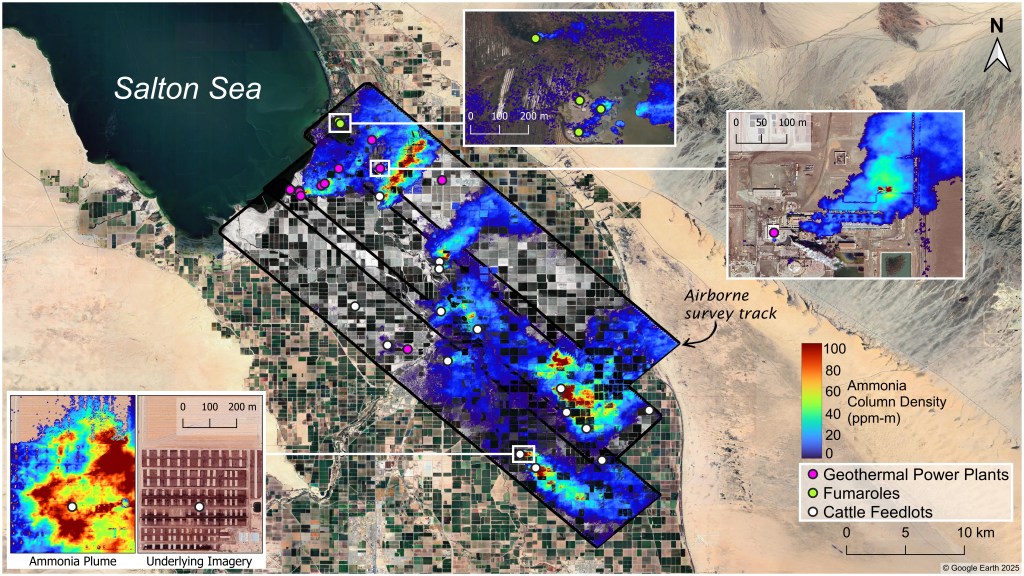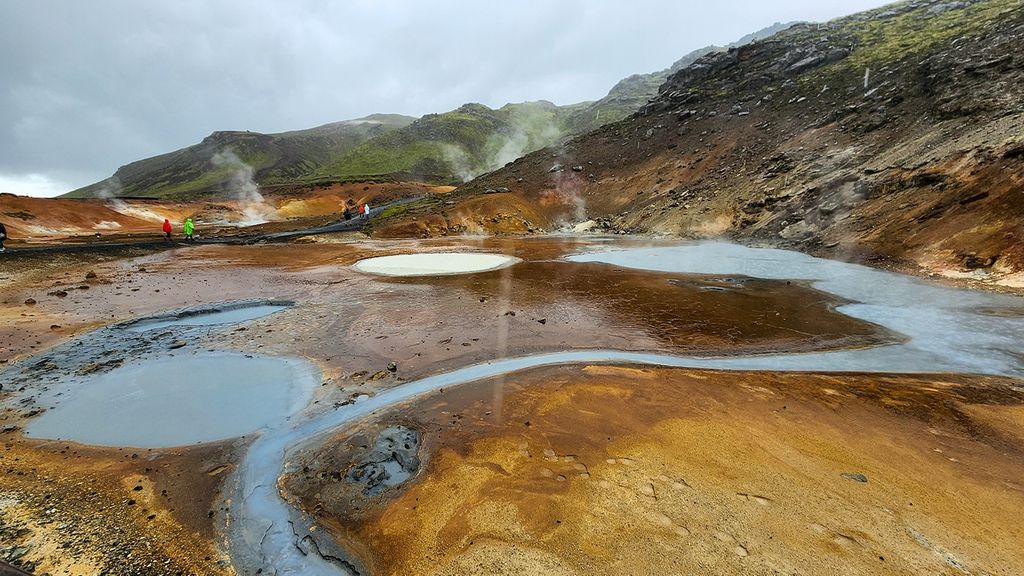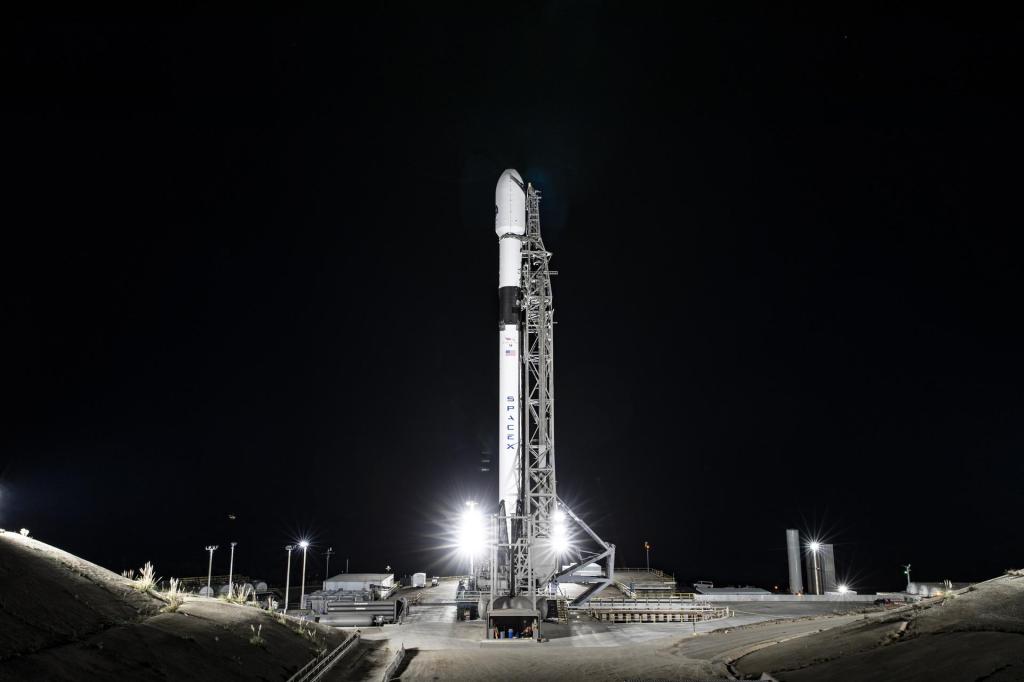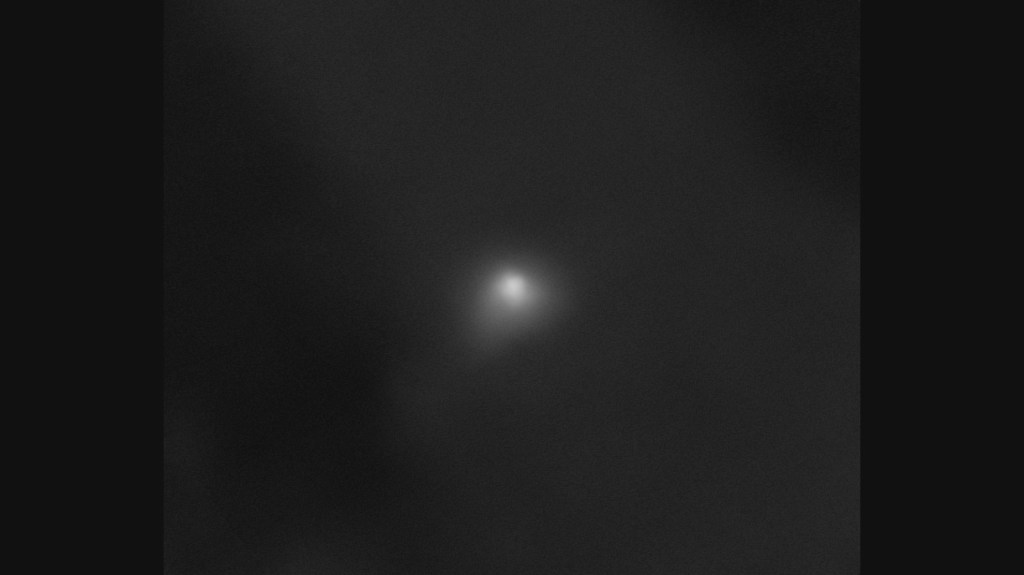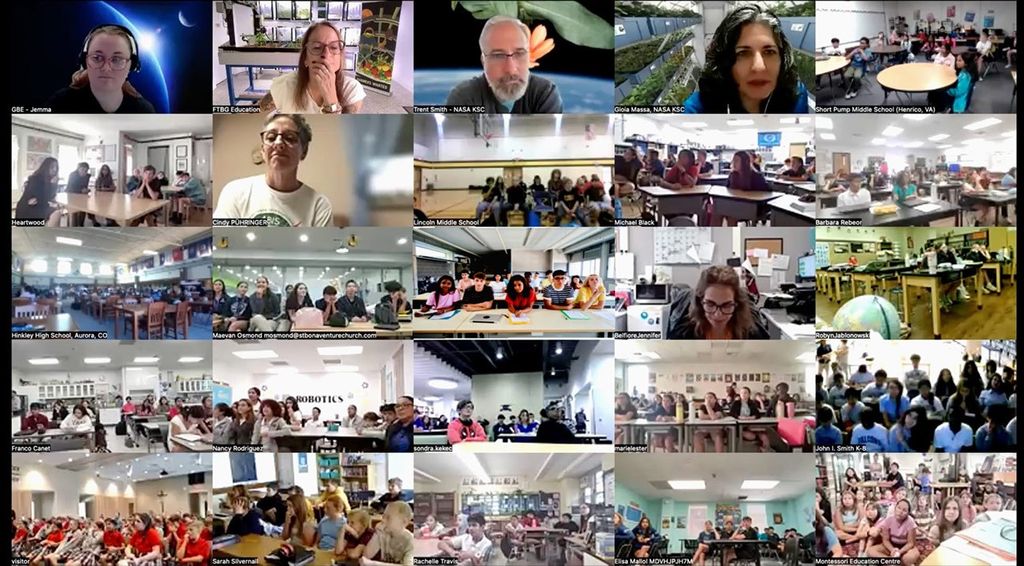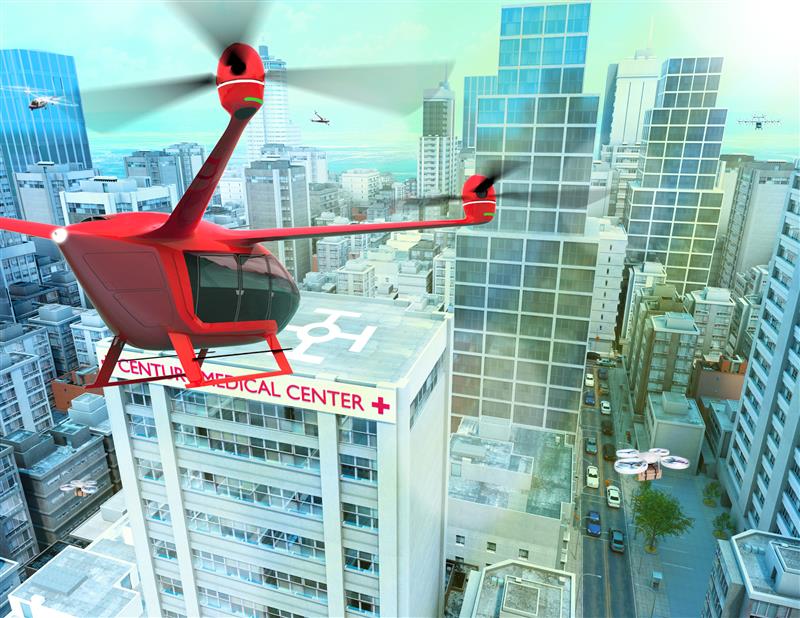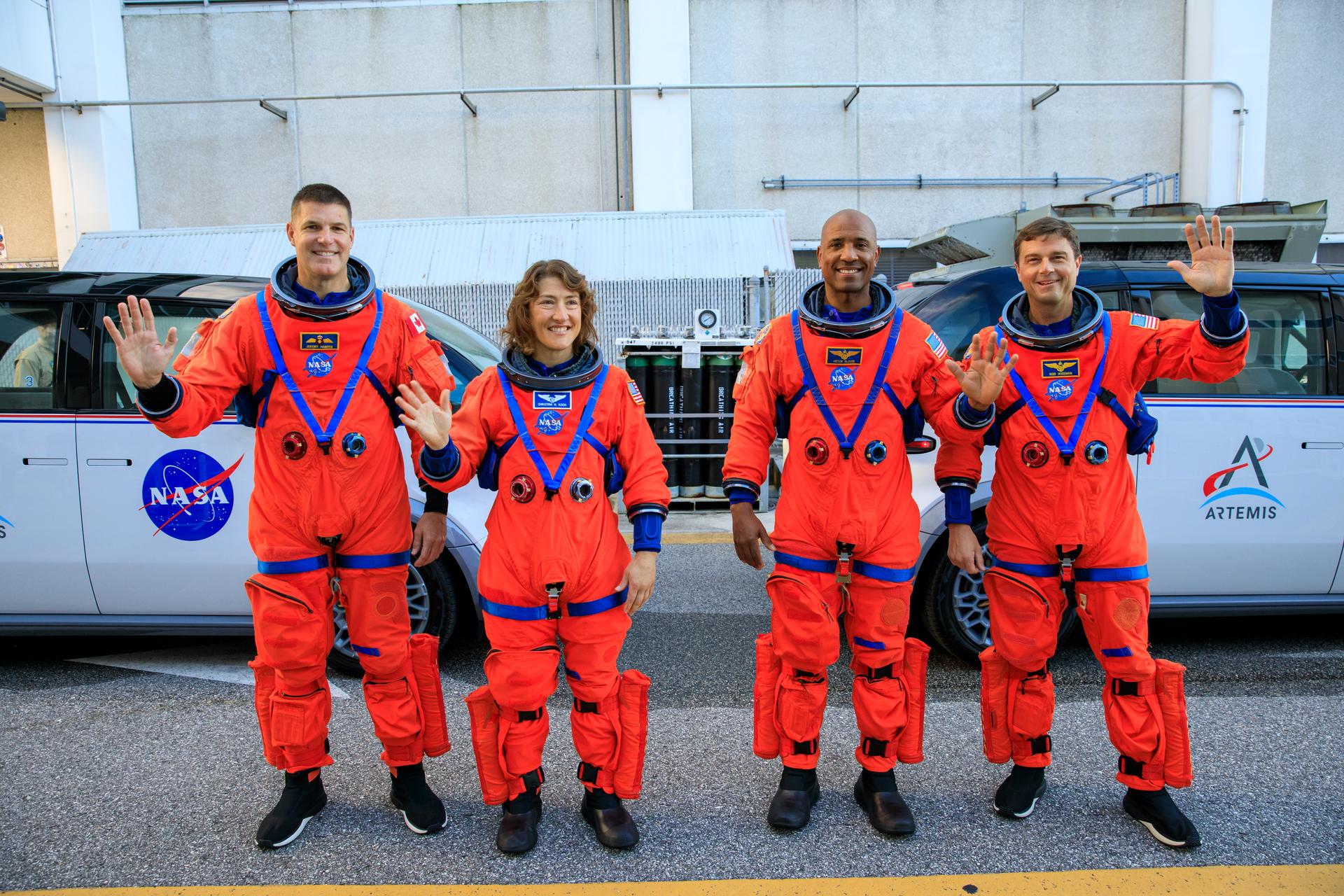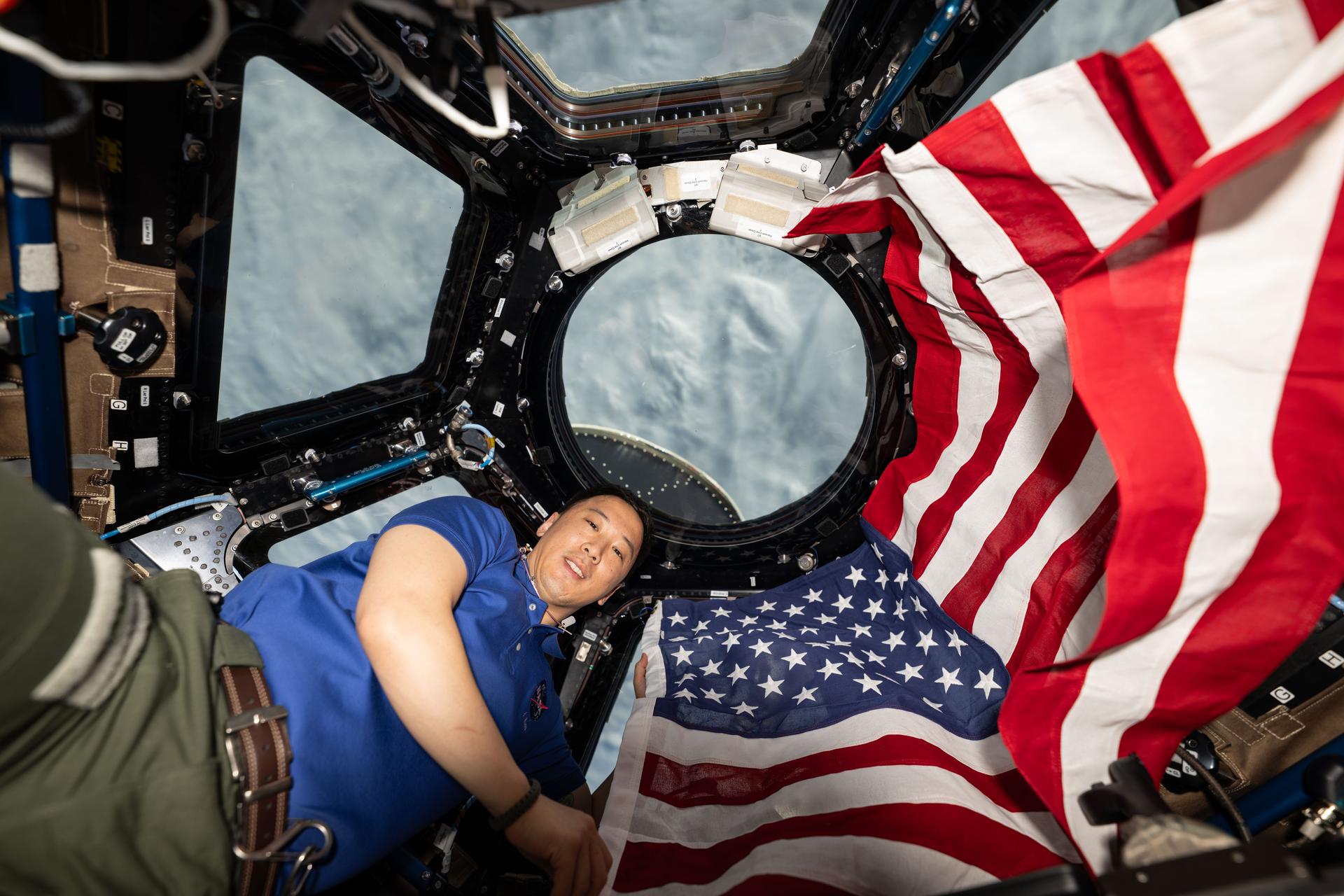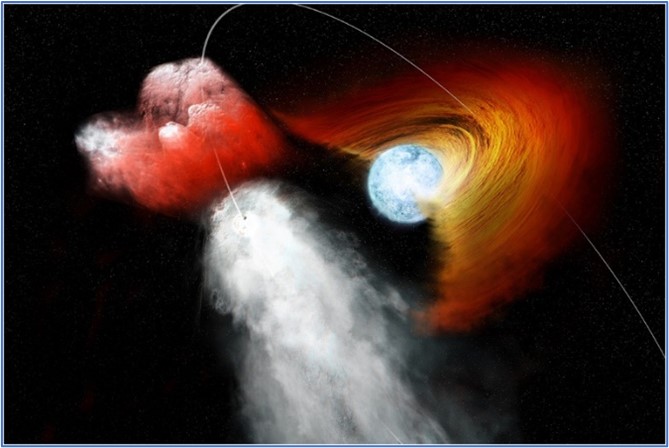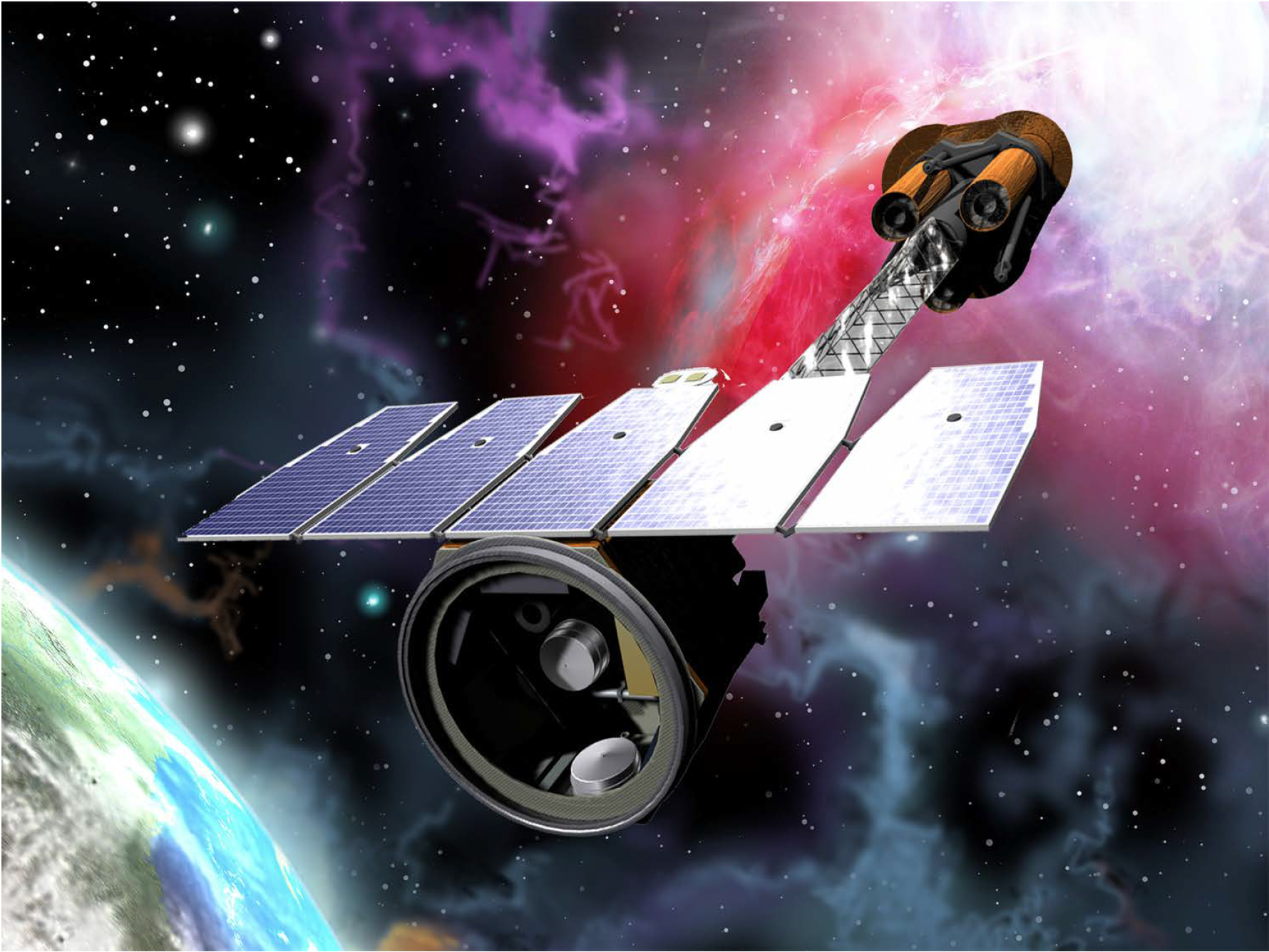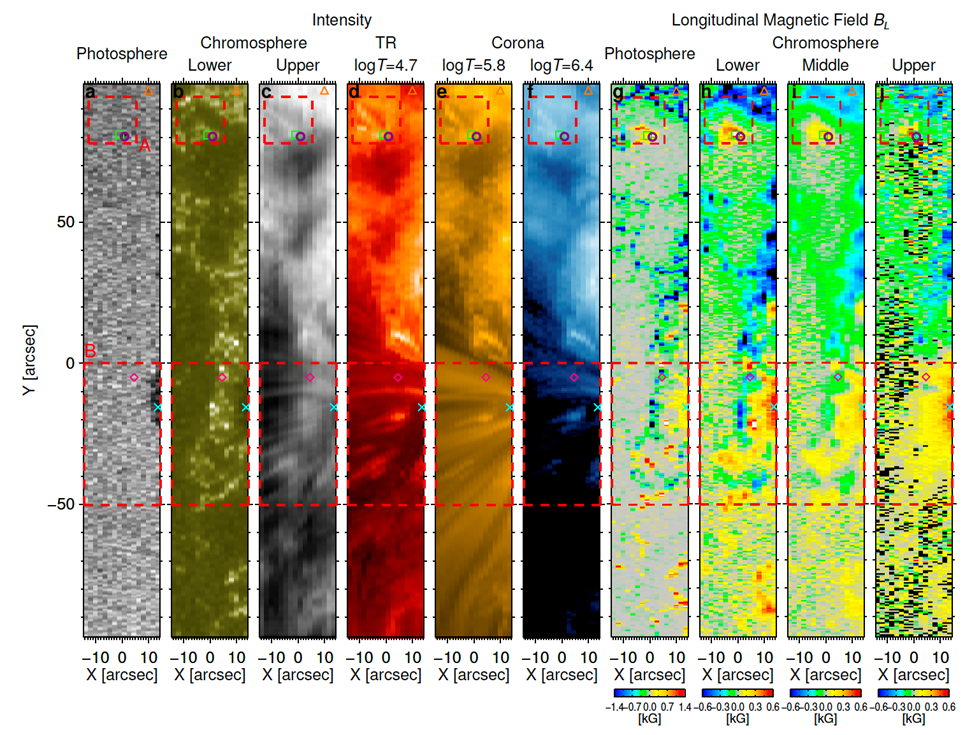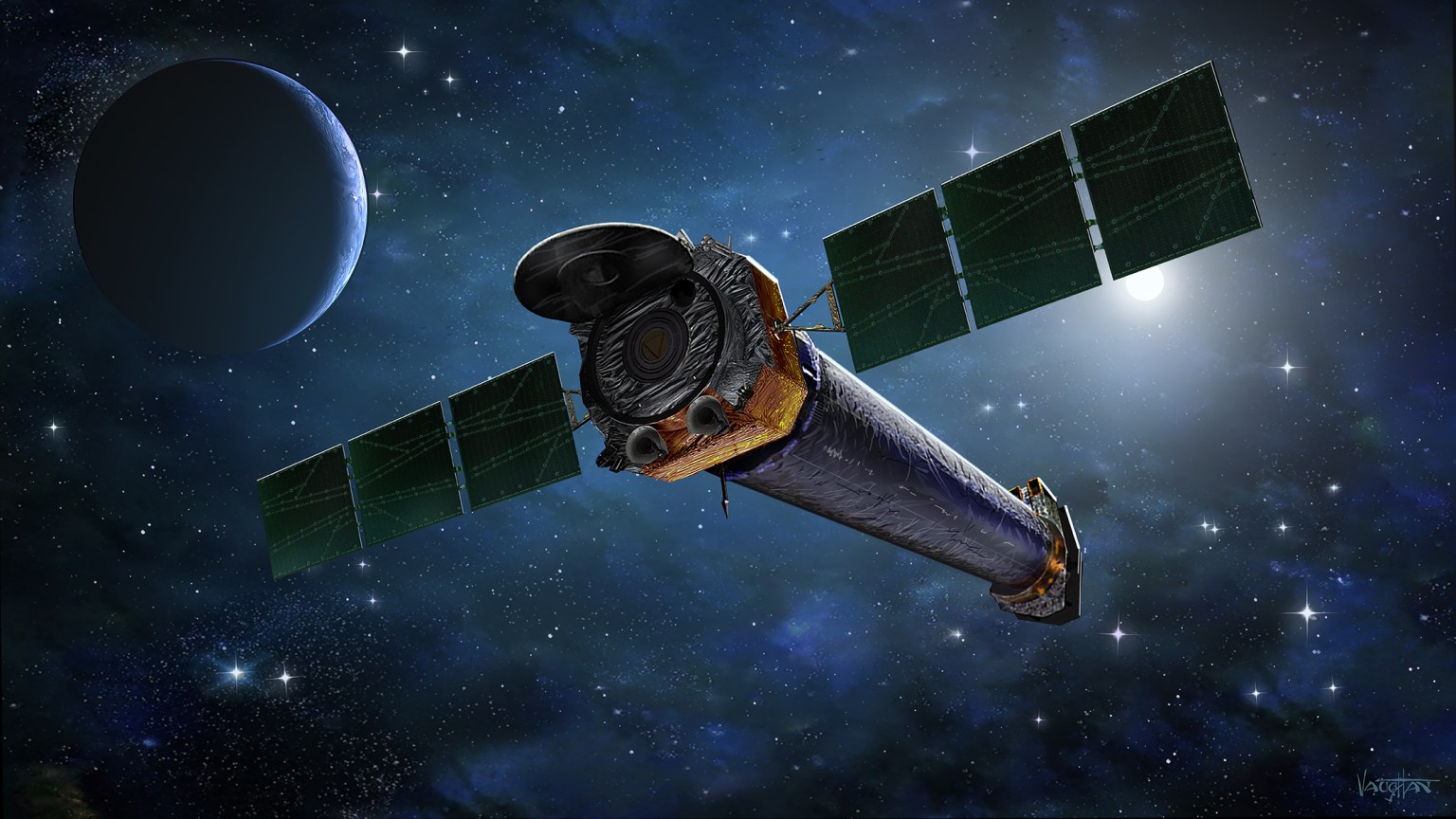Marshall Space Flight Center
Science Publications 2025
Astrophysics
An Energetic Celestial Dance: Nuclear Spectroscopic Telescope Array (NuSTAR) Observations of PSR B1259-63
The results of four “snapshot” NuSTAR observations last year of a dynamic pulsar (PSR B1259-63) in orbit around a massive O-type star (LS 2883), was recently published by Marshall Astrophysicist, Oliver Roberts et al. in the Astrophysical Journal article “NuSTAR Analysis of the 2024 Periastron Passage of TeV Binary PSR B1259-63.” PSR B1259-63 enters and exits the stellar wind of LS 2883 twice as part of its eccentric, ~3.4-year cosmic do-si-do. In doing so, sparks fly as a shock cone forms where the pulsar interacts with the seed electrons in the wind, accelerating them to very high energies spanning the X-ray and gamma-ray regimes, up to several TeV (teraelectronvolt). Current theory purports the observed high energy emission is a delicate balance between the competing acceleration timescale of the relativistic electrons in the shock cone that produce the synchrotron, X-ray emission, and the energy-loss timescale of the same seed electrons. The NuSTAR results show the spectrum of energetic particles shifts towards higher energies one to fourteen days after the pulsar plunges through the wind from LS 2883, which is at odds with leading models that anticipate a less energetic spectrum, implying a longer acceleration timescale. Conversely, the results show a longer energy-loss timescale resulting in electrons being more efficiently accelerated to higher energies in a shock cone that is closer to LS 2883 than the magnetosphere of the pulsar. These NuSTAR results therefore provide further essential information on the interaction region and timescales of the seeding electrons that produce the X-ray emission and a little more insight into the more complicated environment of this stellar duo. View the article here.
Imaging X-ray Polarimetry Explorer (IXPE) Discovery Papers
On Jun. 20, 2025, the Astrophysical Journal published online “A Two-week IXPE Monitoring Campaign on Mrk 421” by Marshall Astrophysicist, W. Peter Maksym et al. On Jul. 10, 2025, the Monthly Notices of the Royal Astronomical Society published online “IXPE Observations of the Blazar Mrk 501 in 2022: A Multiwavelength View” by Lindey Lisalda (Washington University in St. Louis) et al. These are the 73rd and 74th discovery papers published by the Imaging X-ray Polarimetry Explorer (IXPE) Science Team.
Publication of Erebor LISA Global Fit Paper
Marshal astrophysics scientist Michael Katz published an article on the “Erebor” algorithm for the Laser Interferometer Space Antenna (LISA) Global Fit, detailing the large-scale algorithm designed and built for Graphics Processing Units (GPUs) due to their energy and cost efficiency. The algorithm is one of the two state-of-the-art algorithms in the LISA Global Fit landscape. The other is also located at Marshall Space Flight Center (GLASS, Tyson Littenberg, Astrophysics Branch). The article, published in Physical Review D, is titled “Efficient GPU-accelerated multisource global fit pipeline for LISA data analysis” and can be found at: https://journals.aps.org/prd/abstract/10.1103/PhysRevD.111.024060.
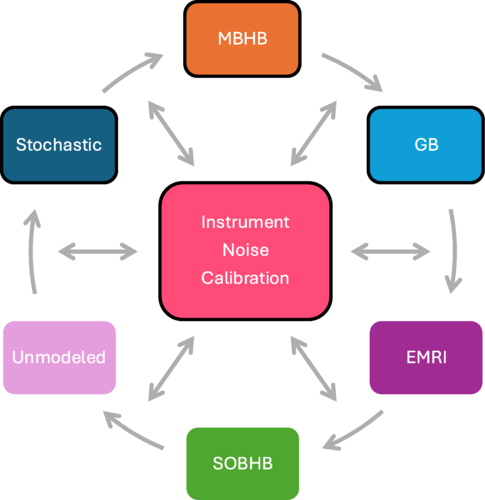
Imaging X-ray Polarimetry Explorer (IXPE) DDT Observation of IGR J1709-3624
On March 20, 2025, Astronomer’s Telegram #17093 posted “IXPE detects a remarkably high X-ray Polarization Degree in a faint hard state of IGR J17091-3624” by M. Parre et al. This accreting stellar-mass black hole is known for recurrent outbursts and exotic variability patterns. Following discovery of a new outburst in early February, the source was observed by IXPE on March 7-10, 2025, in response to a Director’s Discretionary Time (DDT) request. Preliminary analysis of the IXPE observation measures an unexpectedly high polarization degree of (9.3±1.8)%, more than twice that of similar sources previously observed with IXPE. While interpretation of this result is still under way, it seems clear that the source’s X-ray-emitting corona has extreme and unexpected geometrical and/or dynamical properties.
Also, on March 11, 2025, Astronomy and Astrophysics published online “IXPE observation of the low-synchrotron peaked blazar S4 0954+65 during an optical-X-ray flare” by Pouya M. Kouch et al. This is the 70th discovery paper published by the IXPE Science Team.
Imaging X-ray Polarimetry Explorer (IXPE) Science Team Publishes 69th Discovery Paper
Astronomy and Astrophysics published online “Evidence for a shock-compressed magnetic field in the northwestern rim of Vela Jr. from X-ray polarimetry” by Dmitry Prokhorov et al. This is the 69th discovery paper published by the Imaging X-ray Polarimetry Explorer (IXPE) Science Team.
Latest IXPE Discovery Papers Published
On Nov. 1, 2024, Astronomy and Astrophysics published “Studying geometry of the ultraluminous X-ray pulsar Swift J0243.6+6124 using X-ray and optical polarimetry” by Juri Poutanen et al. Read the article here.
On Nov. 15, 2024, Astronomy and Astrophysics published “Probing the polarized emission from SMC X-1: The brightest X-ray pulsar observed by IXPE” by Sofia Forsblom et al. This is the 68th discovery paper published by the IXPE Science Team. Read the article here.
Heliophysics and Planetary
Manuscript “Determining the Magnetic Field in the Atmosphere of a Solar Active Region Observed by the CLASP2.1 Sounding Rocket Experiment” Accepted for Publication
Marshall Heliophysicists, David McKenzie, Ken Kobayashi, Adam Kobelski, Genevieve Vigil, and Amy Winebarger are co-authors of a ground-breaking analysis of data from the Chromospheric Layer Spectropolarimeter 2.1 (CLASP2.1) sounding rocket mission, which measured the spectroscopically resolved polarization of critical ultraviolet spectral lines from the Sun’s chromosphere during its 6-minute flight in October 2021. Analysis of the polarization yields a quantitative measurement of the strength and spatial variation of the magnetic field in the Sun’s chromosphere; CLASP2.1 represents the first-ever two-dimensional mapping of the magnetic field at three heights in this critical layer simultaneously. Of note, the manuscript was accepted on first submission, without revisions, for publication in The Astrophysical Journal.
Paper on Small-scale Solar Events Accepted for Publishing
Dr. Alphonse Sterling of Marshall Space Flight Center’s Heliophysics and Planetary Science Branch is a co-author on a paper describing solar eruptions occurring on size scales several orders of magnitude less energetic than those that produce typical solar flares and coronal mass ejections (CMEs). The paper is titled “Transition Region Brightenings in a Moss Region and their Relation with Lower Atmospheric Dynamics.” The study was led by Bhinva Ram, who is a student of Sterling’s former postdoc Dr. Tanmoy Samanta, currently working in India. The paper will appear in The Astrophysical Journal and a preprint is accessible online.
Marshall Scientist Invited to Write Yearly Review for the Atmospheric and Space Environments Technical Committee
Dr. Linda Habash Krause of Marshall Space Flight Center’s Heliophysics and Planetary Science Branch is first author on a paper describing significant events in missions, laboratory facilities, and models for the Atmospheric and Space Environments Technical Committee (ASETC) 2024 Year-In-Review (YIR). This paper will be published in the December issue of Aerospace America, the American Institute for Aeronautics and Astronautics’s (AIAA) monthly journal. Each year, AIAA publishes significant accomplishments in specialized fields. These accomplishments are monitored by the AIAA Technical Committees and Krause was invited by the ASETC Chair to write this year’s review. The article’s headline is: “Sounding rocket launches, new public models, and data highlight progress for the 2024 ASETC YIR.” Three Marshall sounding rocket missions, the Marshall Grazing Incidence X-ray Spectrometer (MaGIXS-2), the High-Resolution Coronal Imager (Hi-C), and the Focusing Optics X-ray Solar Imager (FOXSI-4) missions are highlighted. The article also covers progress in space simulation chambers, new models available to the public, updates at NASA’s Community Coordinated Modeling Center, and a tribute to decommissioned sources of Atmospheric and Space Environemts data that were retired in 2024.
Earth Science
New Data in Action Story Featuring the United States Geological Survey’s (USGS’s) Use of OPERA DSWX to Monitor Streamflow in Alaska
“Protecting Lives and Livelihoods Across Alaska With NASA Surface Water Data,” a new article published on the EARTHDATA website, details how the U.S. Geological Survey (USGS) is able to leverage the Observational Products for End-Users from Remote Analysis (OPERA) Dynamic Surface Water Extent (DSWx), to monitor streams in Alaska that are challenging to monitor using traditional means. DSWx is part of NASA’s OPERA suite, a Satellite Needs Working Group solution that provides near-real-time surface water extent. USGS has been able to customize an algorithm to compute streamflow for difficult environments where in situ monitoring is challenging. Read the article here.

Short-term Prediction Research and Transition (SPoRT) Innovation on Lightning-initiated Wildfires Accepted for Publication
A Short-term Prediction Research and Transition (SPoRT) innovation study led by Marshall Earth Scientist, Jonathan Case, was recently accepted for publication in the American Meteorological Society’s Journal of Applied Meteorology and Climatology and is currently available as an Early Online Release. Marshall Earth Scientists, Christopher Schultz and Christopher Hain, are co-authors on the article titled, “Characterizing rainfall and land surface conditions associated with lightning-initiated wildfires.” This study examines the importance of antecedent land surface properties in conjunction with rain rates associated with lightning-initiated wildfires in the United States. Steadily declining soil moisture and evaporative stress of live vegetation preceded lightning initiated wildfires. Rain rates were the most important factor in determining whether lightning will ignite wildfires; however, drier surface soil moisture and slightly wetter deep soil moisture occurred at lightning flash locations that initiated wildfires. Rain rates and soil moisture were notably higher for holdover wildfires that were identified at least a day or more after lightning ignition, whereas vegetation was less stressed on average in holdover wildfires.
Manuscript on Manually Labeled, Multi-sourced, High-resolution Flood Dataset Published
Marshall Earth Scientists, Alex Melancon and Andrew Molthan, collaborated with researchers from Beth Tellman’s research team at the University of Arizona to build a manually labeled dataset based on flooding visible in PlanetScope optical imagery. PlanetScope imagery was provided by the NASA Commercial Satellite Data Acquisition (CSDA) Program as was funding for this project. Fellow Earth Scientist, Iksha Gurung, facilitated this work by providing support for the NASA ImageLabeler tool, which was used to generate 366 hand-annotated labels covering 19 global flood events from 2017 to 2020. These labels, collocated with imagery from ESA’s Sentinel-1 and Sentinel-2 missions, provide an extensive dataset that can be used for training and validation of machine learning algorithms used to model flooding and water extent. The FloodPlanet dataset is published on Zenodo, and the full manuscript, titled “Assessing Inundation Semantic Segmentation Models Trained On High- Versus Low-Resolution Labels Using Flood Planet, a Manually Labeled Multi-Sourced High-Resolution Flood Dataset,” is available here.
Marshall Earth Scientist is Coauthor on Article about Aerosol Effects on Convection
Marshall Earth Scientist, Timothy Lang, is a coauthor on a recently accepted peer-reviewed publication in the journal Atmospheric Chemistry and Physics, titled “Observed impacts of aerosol concentration on maritime tropical convection within constrained environments using airborne radiometer, radar, lidar, and dropsondes.” The study used airborne data from the Cloud, Aerosol and Monsoon Processes Philippines Experiment (CAMP2Ex) to study how tropical convection is impacted by aerosols and the meteorological environment. Key to the study was subsetting the meteorological environment according to different measures that are known to affect cloud development (e.g., instability) and then studying how aerosols affect convection in those different environments. Results were mixed, but some comparisons indicated that medium-to-high aerosol concentrations were occasionally strongly correlated with convective intensity and prevalence, especially when the atmosphere was relatively unstable. Earth Scientist Corey Amiot – who works at the National Space Science Technology Center located on University of Alabama in Huntsville – led this study and completed most the research when he was a NASA Postdoctoral Fellow at Marshall. The study included data from Marshall’s Advanced Microwave Precipitation Radiometer (AMPR) instrument and demonstrated the power of a combined multi-sensor observing suite for studying complex processes such as aerosol impacts on clouds and precipitation. Read the full article here.
Marshall Earth Scientist Co-authors Publication on Synthetic Aperture Radar (SAR)
Marshall Earth scientist Africa Flores-Anderson joined researchers from the University of Alaska Fairbanks (UAF) and NASA’s Jet Propulsion Lab (JPL) in an Institute of Electrical and Electronics Engineers (IEEE) article titled “Facilitating the Golden Age of Synthetic Aperture Radar: New tools, services, and training to make synthetic aperture radar data more accessible.” The article, spearheaded by Franz Meyer (UAF), was published in the IEEE Geoscience and Remote Sensing Magazine, and showcases initiatives for improving SAR data accessibility. Flores-Anderson emphasized the global reach and influence of the SAR Handbook and respective training materials. You can read the article at: https://ieeexplore.ieee.org/document/10880111.
Marshall Earth Scientist is Co-author of Article on Turbulence in Snowstorms
Marshall Earth scientist Timothy Lang is a coauthor on a recently accepted peer-reviewed publication in the Journal of Geophysical Research – Atmospheres, titled “Supercooled Liquid Water at the Top of a Snow-Producing Nimbostratus Cloud and Its Association with Gravity Wave Breaking and Turbulence: an IMPACTS case study.” The Investigation of Microphysics and Precipitation for Atlantic Coast-Threatening Snowstorms (IMPACTS) campaign occurred from 2020 to 2023 and featured synchronized use of the NASA ER-2 aircraft in a remote-sensing role and a NASA P-3 in an in-situ measurement role. The case study analyzed in this paper observed the enhancement of microphysical processes and precipitation formation in turbulent regions of a snowstorm. Lang assisted with the retrievals of turbulent energy using a cloud radar on the ER-2, made possible by the use of the Python Turbulence Detection Algorithm (PyTDA), which Lang developed and open sourced. The application of PyTDA to airborne radar is novel and led to accurate retrievals that matched reasonably well with in-situ sensors on the P-3. Marshall also contributed the Advanced Microwave Precipitation Radiometer (AMPR) and the Lightning Instrument Package (LIP) sensors to IMPACTS. Read the article at: https://agupubs.onlinelibrary.wiley.com/doi/10.1029/2024JD041795?af=R.
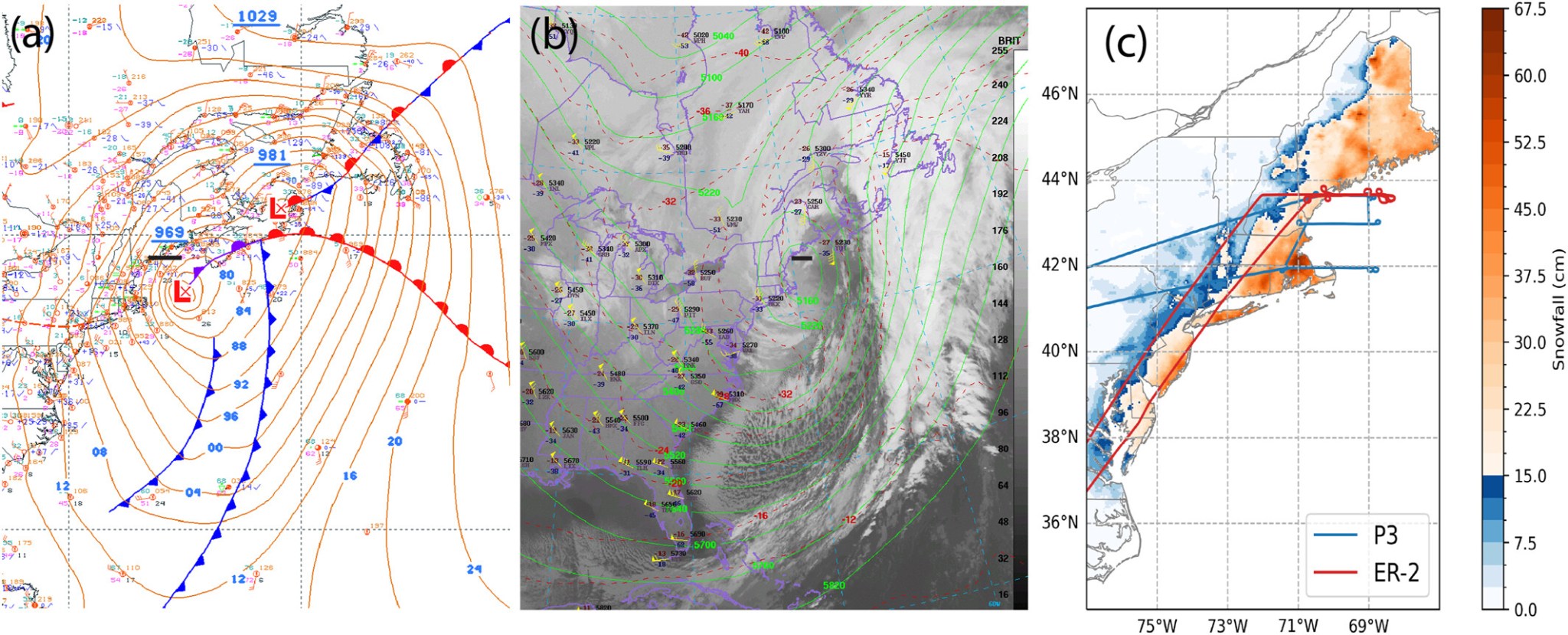
Leveraging Educational Partnerships to Integrate Education for Sustainable Development into University Geoscience Curriculum Paper Published
How can higher education institutions better equip future professionals to address environmental and development challenges using the perspective from space? Building on a partnership between NASA and the University of Twente, Micky Maganini, Kelsey Herndon, and Rob Griffin from the University of Alabama Huntsville Lab for Applied Science, and Eric Anderson, a Marshall Earth Scientist, partnered with the University of Twente’s Faculty of Geo-Information Science and Earth observations (ITC) to address this question. In a recent paper titled “Leveraging educational partnerships to integrate education for sustainable development into university geoscience curriculum,” published in the International Journal of Sustainability in Higher Education, the team presented novel framework and case studies illustrating how academic partnerships can catalyze the integration of Earth observations-driven content into applied Earth science programs of study. Curricula were built off NASA’s SERVIR open access tools and are freely and openly accessible online. Read the paper at: https://www.researchgate.net/publication/389601358_Leveraging_educational_partnerships_to_integrate_education_for_sustainable_development_into_university_geoscience_curriculum
Synthetic Aperture Radar Paper on Active Agriculture Published
Kaylee Sharp of NASA’s Marshall Space Flight Center’s Earth Science branch recently had her first manuscript, titled “Modifying NISAR’s Cropland Area Algorithm to Map Cropland Extent Globally,” accepted and published in a special issue of Remote Sensing. The manuscript explored a new methodology of identifying active agricultural fields of certain major crops globally, without needing to rely on reference datasets. The base algorithm, the Coefficient of Variation, is the algorithm that will be used by the NISAR science team to calibrate and validate the soon to launch NASA-ISRO SAR (NISAR) mission, was improved upon for this paper. The special edition was titled NISAR Global Observations for Ecosystem Science and Applications, and the work done was in collaboration between Marshall Space Flight Center, The University of Alabama Huntsville, and the Alaska Satellite Facility. Read more at: https://www.researchgate.net/publication/390029131_Modifying_NISAR’s_Cropland_Area_Algorithm_to_Map_Cropland_Extent_Globally.
Article on Large Language Models in Scientific Research Published
Marshall scientists Rahul Ramachandran and Kaylin Bugbee collaborated on an article for the American Geophysical Union’s journal Perspectives of Earth and Space Scientists that was published on March 12, 2025, titled “Balancing Practical Uses and Ethical Concerns: The Role of Large Language Models in Scientific Research.” This study looks at how NASA’s Science Mission Directorate (SMD) is exploring the use of Large Language Models (LLMs) and generative AI to accelerate scientific discovery, and its unique challenges related to accountability, transparency, and replicability. Additionally, NASA collaborated with IBM Research to develop INDUS models tailored to specific science tasks. There is also research into creating a Retrieval-Augmented Generation strategy that combines INDUS with generative models to minimize risks and ground responses in authoritative sources. The article can be found here: https://agupubs.onlinelibrary.wiley.com/doi/10.1029/2024CN000258.
Marshall Earth Scientist Co-authors Publication on Synthetic Aperture Radar (SAR)
Marshall Earth scientist Africa Flores-Anderson joined researchers from the University of Alaska Fairbanks (UAF) and NASA’s Jet Propulsion Lab (JPL) in an Institute of Electrical and Electronics Engineers (IEEE) article titled “Facilitating the Golden Age of Synthetic Aperture Radar: New tools, services, and training to make synthetic aperture radar data more accessible.” The article, spearheaded by Franz Meyer (UAF), was published in the IEEE Geoscience and Remote Sensing Magazine, and showcases initiatives for improving SAR data accessibility. Flores-Anderson emphasized the global reach and influence of the SAR Handbook and respective training materials. You can read the article at: https://ieeexplore.ieee.org/document/10880111.
Paper titled “Nighttime Lights and Population Variations in Cities of South/Southeast Asia: Distance-Decay Effect and Implications” Published
Krishna Vadrevu of NASA’s Marshall Space Flight Center’s Earth Science Branch served as the lead corresponding author, on the paper published in the journal Remote Sensing titled “Nighttime Lights and Population Variations in Cities of South/Southeast Asia: Distance-Decay Effect and Implications” with Griffin McAvoy of the University of Alabama Huntsville as the first author. The research focuses on utilizing Visible Infrared Imaging Radiometer Suite (VIIRS) nighttime light (NTL) brightness satellite data to analyze urbanization patterns across 323 cities in 17 countries in South and Southeast Asia (S/SEA).
Urbanization in countries of S/SEA is a dynamic and complex process driven by rapid population growth and economic development. The study identified significant patterns and challenges related to urban expansion and a negative exponential relationship between NTL brightness and distance from the city center was observed in all major cities. These findings suggest that a 105 km radius effectively delineates the extent of major metropolitan regions. The VIIRS NTL satellite data proved valuable in distinguishing urban, peri-urban, and rural areas. Overall, the study emphasizes the importance of adaptive urban planning, infrastructure development, and sustainable practices in addressing the challenges of urbanization in South and Southeast Asian countries. This research was conducted as part of the South/Southeast Asia Research Initiative (SARI), led by Vadrevu, with funding from NASA’s Land Cover/Land Use Change Program. Read the full paper here.
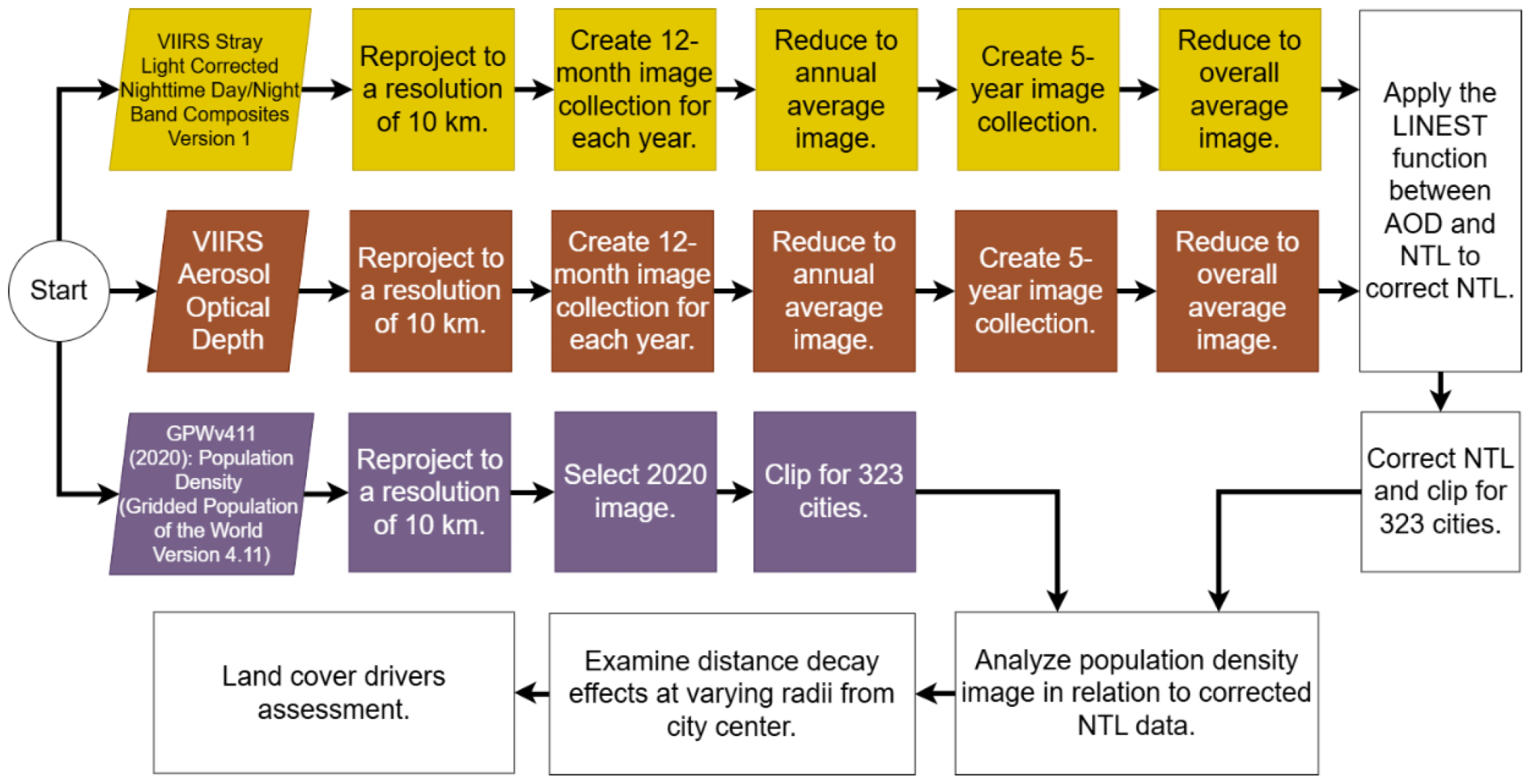
Marshall Scientist’s Paper on Strengthening Food Self-Sufficiency Published in Georgia
In conjunction with a research project studying the environmental impacts of political and societal change in the Caucasus over the past 30 years, Dr. Pontus Olofsson of Marshall Space Flight Center has co-authored a paper that has been accepted for publication in Environmental Research: Food Systems. The paper describes the study of the potential for sustainable agricultural intensification in the country of Georgia, where political upheaval, such as the collapse of the Soviet Union, has led to a sharp decline in agricultural productivity, leaving Georgia highly dependent on food imports. Closing this yield gap in Georgia through sustainable intensification has the potential to increase food self-sufficiency, support rural livelihoods, and strengthen food security and sovereignty. To achieve sustainable intensification, farmers will need training in using different crop varieties, fertilizers, and pest and disease control practices and products. The high employment rate in the agricultural sector of Georgia provides opportunities to reduce poverty and increase quality of life by increasing incomes and food security. As principal investigator, Olofsson’s research was funded through a grant from the NASA Land-Use & Land-Cover Change Program. Read the paper here.

